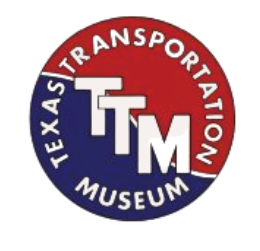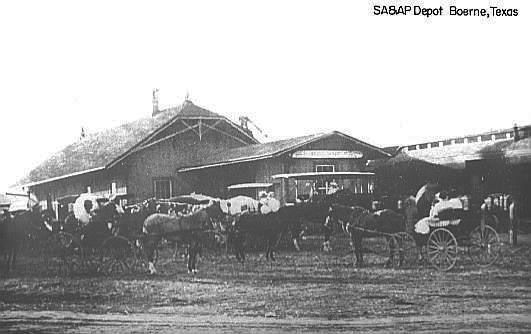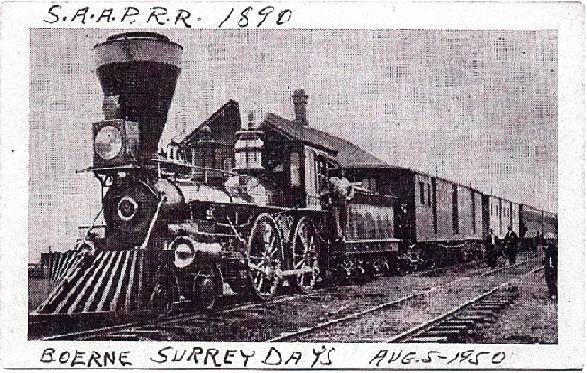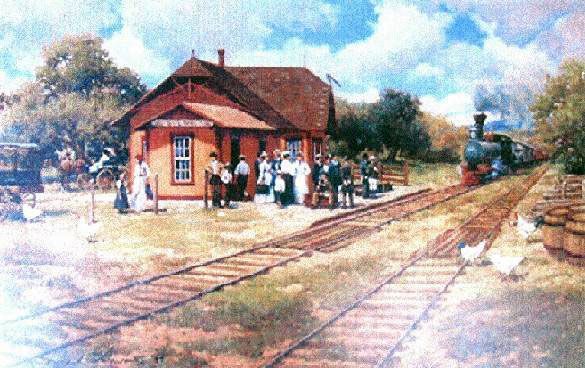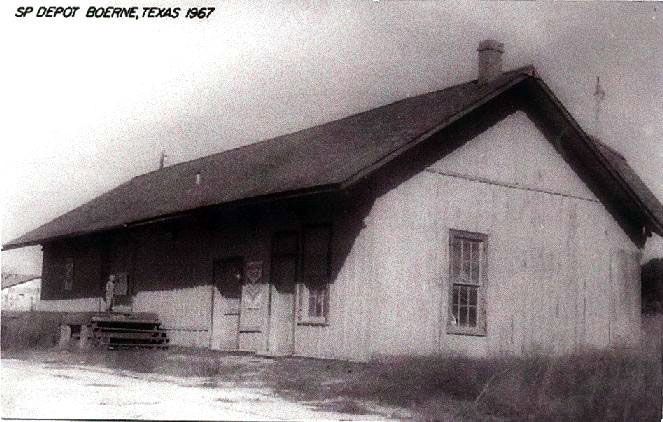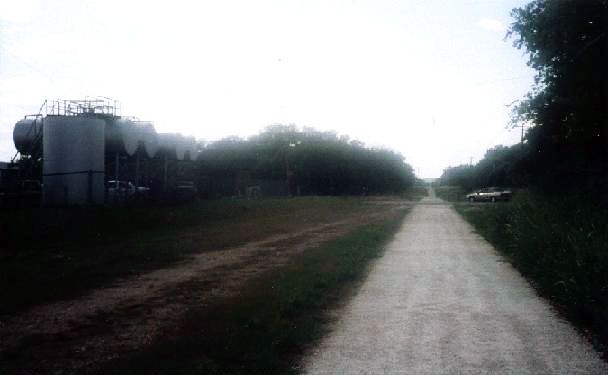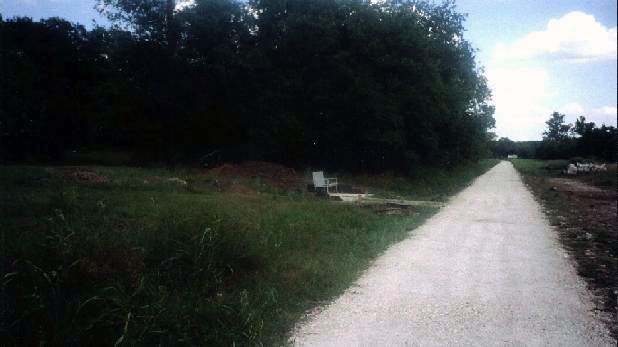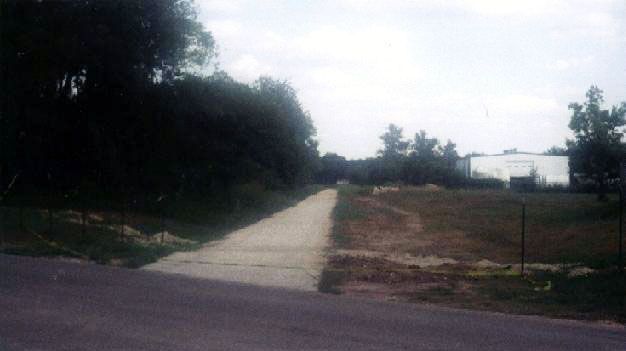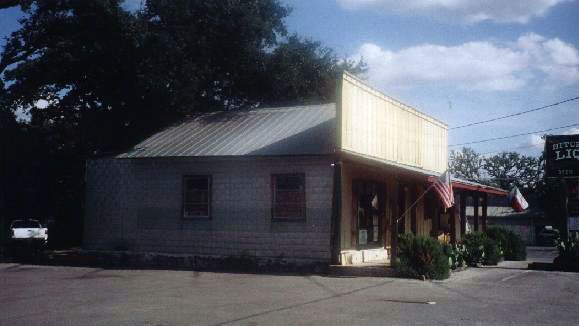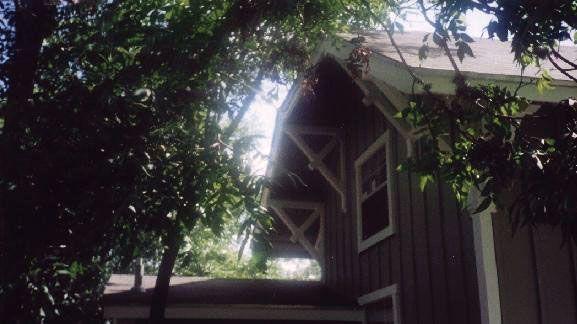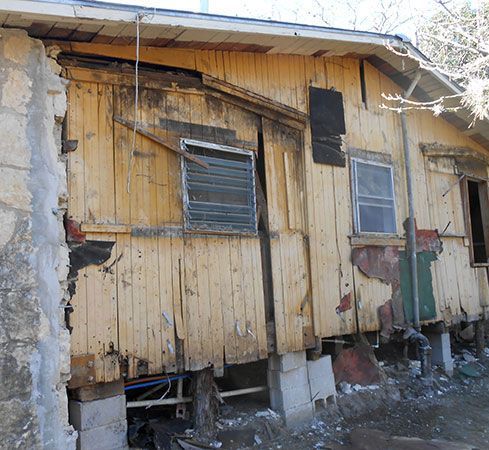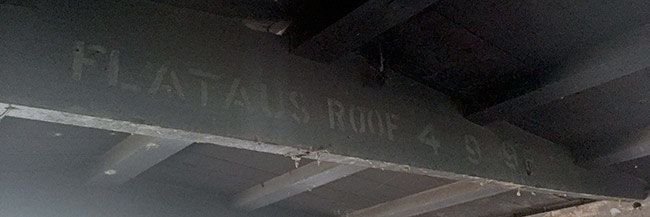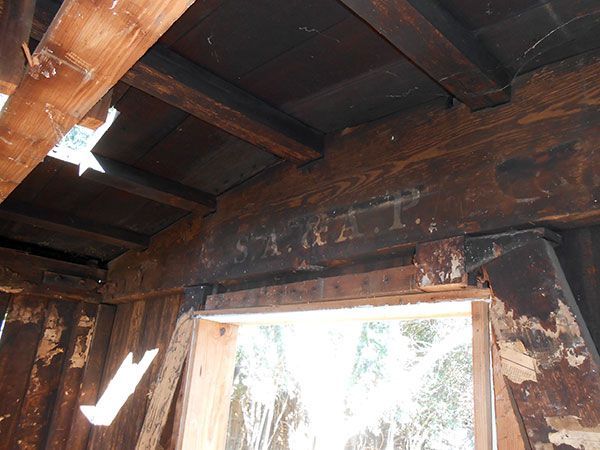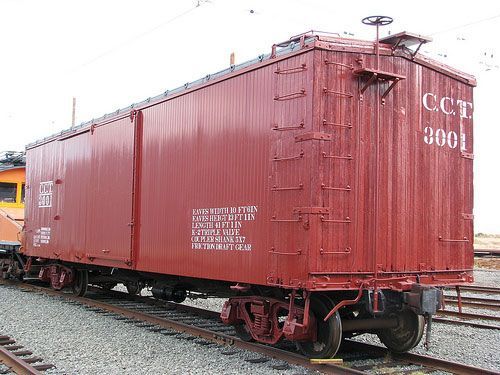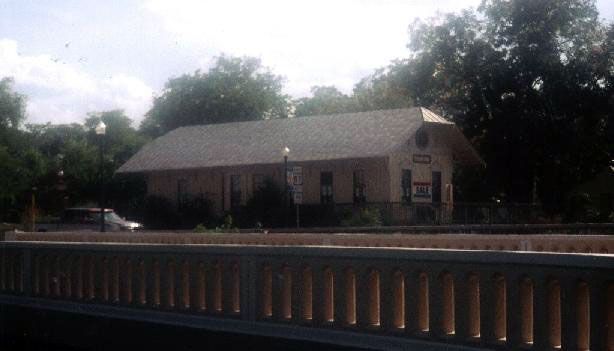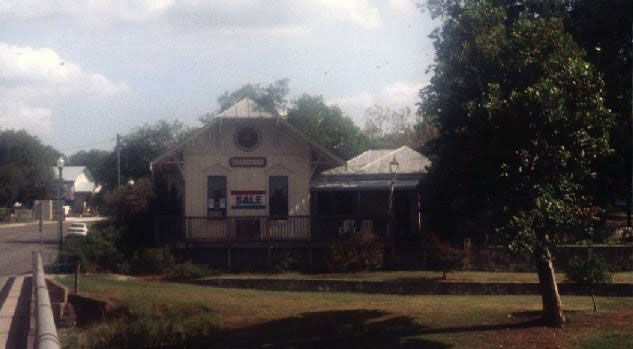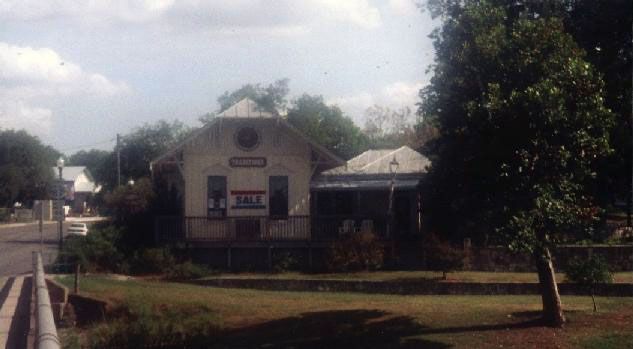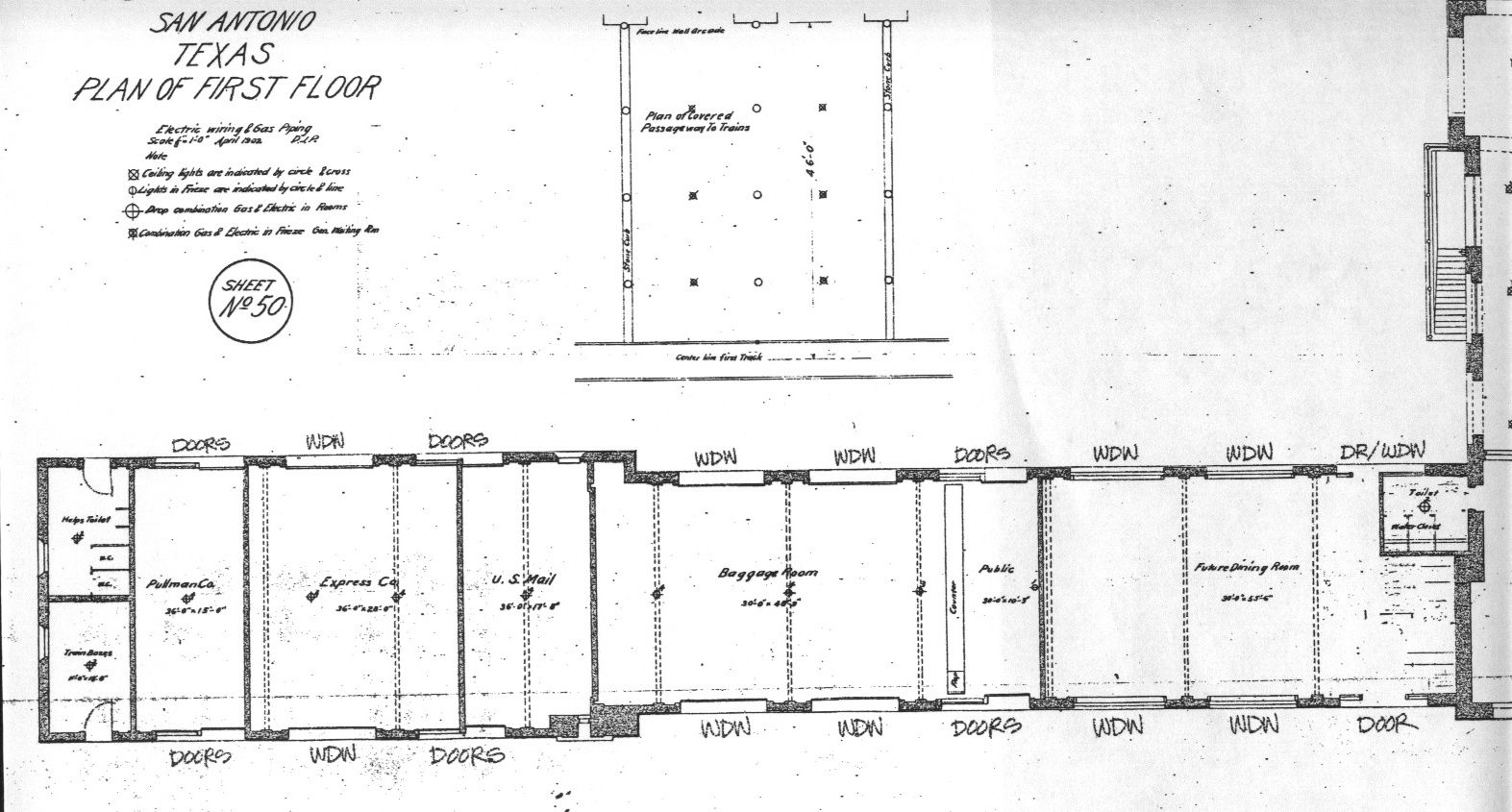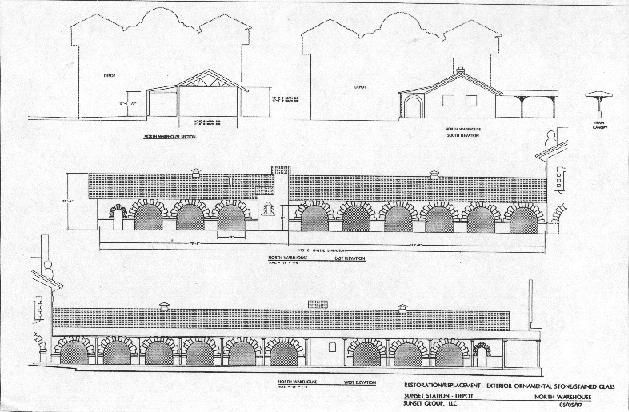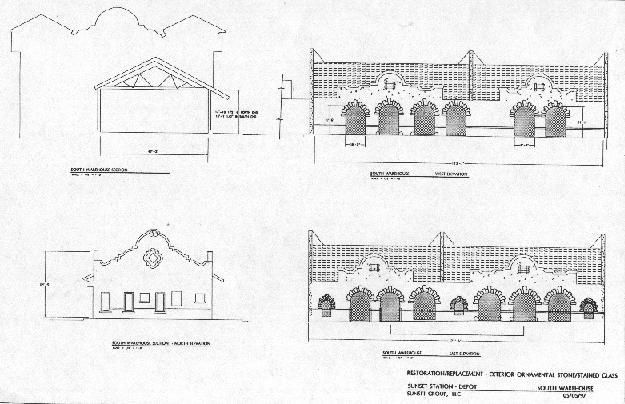Boerne and the Railroad
We are deeply indebted to Boerne Library for their generous assistance with much of the information and most of the pictures used here. In particular, Bettie Edmonds, took a lot of time to both find materials and answer questions. She created a small booklet in 1999, the year of Boerne's 150th anniversary, called The Journey To Boerne which is a fascinating introduction to the history of this vibrant community. It is available upon request for the amazing price of only $2.00 at the library.
While the story of railroad service to Boerne - pronounced "burnie" due to its German origin - begins in March of 1887, the town itself dates back to around 1851. It was founded during the time of the largest German immigration to the USA. As the diaspora began to fan out from New Braunfels, more and more new towns were established, creating places like Fredericksburg, Comfort and Sisterdale. Boerne became the county seat of Kendall county in 1862, but the courthouse was not finished until seven years later, due to many hardships, not the least of which were the Civil War and indigenous Native Americans, who were not so kindly named back then.
Times were hard all over and the population of Boerne was beginning to decline following the failure of attempted large cattle ranching and associated drives up to Kansas and its railheads to the northern states. The coming of the railroad was an economic boost of some magnitude, and it created infinitely better conditions for the area. The population stabilized and began to grow. Both people and their produce could be moved with an exponential improvement in time taken and conditions to be endured en route. The cities of Boerne and Fredericksburg petitioned for the creation of rail service and when the $180,000.00 subscription asked of Boerne was forthcoming, the line was built with surprising speed. It was started on August 26, 1886 and service began in the march of the following year.
To understand the huge impact the arrival of the railroad would have you have to consider the prevailing conditions for travel and the transportation of goods. Boerne is thirty miles north west of San Antonio. It is 1,500 feet above sea level which is 800 feet higher than San Antonio. A trip to San Antonio by stage coach would take over seven hours, perhaps longer during inclement weather. There were no paved roads then and the trails would become nothing but muddy ruts whenever it rained. Moving goods was even more arduous. By horse and buggy or, more commonly, by ox pulled cart, the journey would take an entire, grueling, day. Moving fruit and vegetables under such conditions would be close to pointless as the produce would be all but rotten by the time you got anywhere. Moving heavy loads of materials, even relatively easy items like bricks, would take for ever, as only small relatively small quantities could be moved on any one wagon. People lived within a small radius of their homes and a trip into town would be a major event.
All this changed on March 12, 1887, when the first San Antonio & Aransas Pass Railroad passenger train arrived in Boerne. It was a huge event for the town, and the cause of much celebration. Now the journey to San Antonio would only take three hours. It would be a whole lot more comfortable than riding in a stage coach, and less expensive, to boot. Poor weather would hardly make a difference. In addition, Boerne residents could get daily newspapers, much improved postal service, and other "luxuries," such as fresh beer.
The first San Antonio and Aransas Pass train for the general public to Boerne is well recorded. There had been a private trip a day or so before for Dr. Ferdinand Ludwig Von Herff, a local landowner who had been a major booster and right of way granter for the new service. On the big day for the regular public, the train left San Antonio at 4:30 PM. It was a Saturday. The train, which consisted of seven bright red passenger coaches, one baggage car and two freight wagons, according to the San Antonio Express was filled to capacity. At 95 cents for a ticket, it carried over 600 people to Boerne and arrived without incident at around 7:00 PM. Travelers were allowed to carry up to 150 lbs of luggage for free but would have to pay extra to move their horses and buggies. There was a huge picnic arranged followed by several speeches from local dignitaries and railroad officials. The train returned to San Antonio the next day.
Soon, as well as daily service, special tourist weekend trains were set up and local hotels and camp grounds emerged to cater to the new trade. Boerne was known for the purity of its air and a new industry grew to cater to people hoping to convalesce in the Hill country. Other spas in the area, such as Hot Wells in San Antonio, were already doing a roaring trade but the appeal of Boerne was even stronger and soon there were around 13 sanitariums and hotels catering to the demand. Another business that was able to flourish was cedar posts, and countless hundreds of tons of them were moved expeditiously by the railroad, creating jobs and more income for the area.
Railroads did not only merely provide transportation. Railroad agents were more than just ticket sellers. Their main job was to develop local business by attracting companies to the area and helping existing businesses to improve their operations. One area at which they excelled was in developing agriculture. As you can see in one of the pictures, there were special Farm Trains that would come to town on a regular basis. As there was no governmental agencies to provide such assistance, railroads took it upon themselves to actively solicit immigration, mainly in Europe, so the potential farm lands around their rail lines would be developed. Such immigrants, many illiterate in English if not their own native tongue, would set up in Texas only to find agricultural opportunities entirely different from those they had experienced in the colder lands they had come from. The Farm Trains were created to help them make the best of what could be done in Texas. The trains would have agricultural experts on board, to show farmers the best methods to use in the often harsh conditions they were finding. The trains would have seed for the best types of crops to sow, and demonstrations of the new farm equipment being developed at that time. Of course, the railroad would be only too happy to help deliver such new equipment plus transport the resulting crops and animals that would result from the gains made by the farmers. Railroads even had migrant labor well organized. They would bring in the required temporary workforce, provide them with shelter, move out the harvest and then move the labor onto another destination.
The handsome depot in Boerne was built around 1906. There were two structures. One, the smaller, was a freight room. The larger building was timber framed and measured approximately 24 by 62 feet. The line did not end in Boerne. It continued on to the northwest going through Comfort and, ultimately, reached Kerrville in August of 1887. The original intention was to continue up to the Texas Panhandle but this never happened. In around 1914 a spur line to Fredericksburg was completed, which connected to the main line just east of Comfort. The Fredericksburg line lasted until 1939, when competition from the new roads that had been built and the lack of freight brought the service to an end. The Southern Pacific was running the San Antonio & Aransas Pass Railroad almost from the very start but it did not officially drop the name until the mid 1920s. It decided to down size the depot in 1959 and it was sold to Paul Driess, of Comfort, who had both the larger and smaller buildings relocated within Boerne. Both still survive today. The smaller building is at 1105 S. Main and contains the Hitching Post Liquor Store. The main building is on a quiet street in Boerne and, though substantially altered for use as a private home, is still recognizable as the old depot it once was.
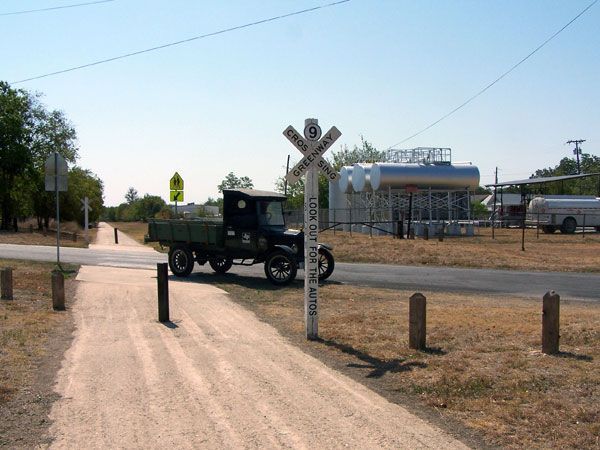
After 1959, a smaller depot was erected, more in keeping with the diminishing role the railroad was performing for the much expanded city. With more cars, better buses, larger trucks, improved roads and the soon to be opened IH 10 freeway on the immediate horizon, fewer and fewer people were using the railroad for transportation. Moving freight has always been the true raison d'etre of the railroads, and the S.P. still perceived a useful role for itself in that regard. It must be said, however, that the whole line up to Kerrville had always been a disappointment and, in fact, the line never made an operating profit. It is surprising that it survived as long as it did, since railroads, notoriously, are not in the charity business. With few industries along the line, and the movement towards trucks for what there was, the line was on borrowed time. Had the tracks ever been extended up to the Panhandle as was originally envisioned, there might have been a role for it to play but it would still have been a diminished one for the communities along the way. As the loads big trucks could carry increased, the need for the railroad declined and the S.P. made the decision to end service along their north west branch line in 1971, according to the Boerne Star on 2/4/71. The second depot was destroyed in a fire some time after the rails were removed, according to a local fireman. For a long time the old right of way was but a ghost of itself. Now a large section has been made into into a handsome nature walk, complete with SA & AP styled shelters and sign posting. Depot Road, leading from Main Street to the station, was renamed Rosewood Avenue a long time ago but the new nature path is bringing Boerne's railroad history back to life, reminding residents of this once important connection to the rest of the world.
House constructed from two old wooden SA & AP box cars in Boerne
When a small abandoned house was being demolished in Boerne in 2016, it was discovered to have been built around two old wooden San Antonio and Aransas Pass freight box cars that were built no later than 1890. Tax records indicate the two cars were moved to the lot not far from the tracks some time in the 1940s. It was not at all unusual for railroads to use old box cars for storage themselves but this is the first time anyone has come across them being used to make a house. The two cars were placed side by side about a box cars width apart. A wooden floor was built in between them and a roof overhead. Over time an additional wooden siding were placed around the structure followed by rock siding even later on. An additional room was added as well that became a laundry area and sun room. It was not until the structure was being demolished that the old box cars were discovered again. While the developer was avidly keen to learn everything he could about the box cars with a view to saving as much of the original structure as possible, it was found the cars had been so altered and cut up over time there was almost nothing left to save except the material itself, which will be re-used by the developer in the future. Remarkably a picture was taken of a very similar SA & AP box car in Kerrville around 1900. The number of one of the car used for the house - #2249 - was found clearly stamped on a beam underneath the car. The car in the image is #2246.
Missouri Pacific railroad depot from Encinal relocated to Boerne
Another reminder of railroad history is far more prominent. Boerne is home to large, handsome, depot, right on Main Street. This one was relocated to a beautiful spot beside the river from its original location in Encinal, Texas, not too far from Laredo. This depot does tend to throw railroad enthusiasts off the tracks, as it were. It is located a long way from where the old right of way ran through Boerne and is built in an entirely different style from any other depot installed by the San Antonio & Aransas Pass Railroad. It was, in fact, constructed by the International & Great Northern which became part of the Missouri Pacific. It is operated as a high end women's fashion boutique called "Traditions At The Depot." Its owners brought the structure and its smaller freight room as well, to Boerne simply because they thought it was a great building. Occasionally, according to the owners, who are very proud of their depot, they get the occasional customer who actually remembers it in Encinal. These folks often get transported back in time as memories of hours spent waiting for the train come flooding back. One older man vividly recalled visiting the depot almost daily with his pals just to pass the time as they waited for trains to come by, their legs dangling from the platform, a pastoral scene of rural Texas life long before television and the interstates, when things were simpler and entertainment came from real life.
Southern Pacific depot from Center Point while in Boerne
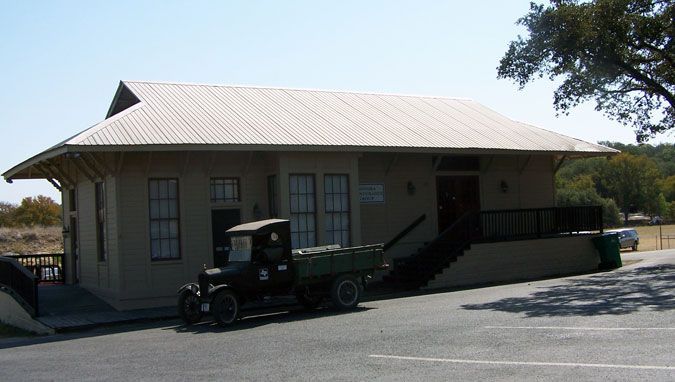
If that wasn't enough, there used to be yet another old railroad depot in Boerne! This one is from further up the line, a place called Center Point, between Comfort and Kerrville. It was locatedat a commercial center comprised of several old, relocated, structures, on the southern edge of town. Click the "Center Point" link in the right hand column for more information and pictures.
Transportation Museum
CONTACT US TODAY
Phone:
210-490-3554 (Only on Weekends)
Email:
info@txtm.org
Physical Address
11731 Wetmore Rd.
San Antonio TX 78247
Please Contact Us for Our Mailing Address
All Rights Reserved | Texas Transportation Museum
